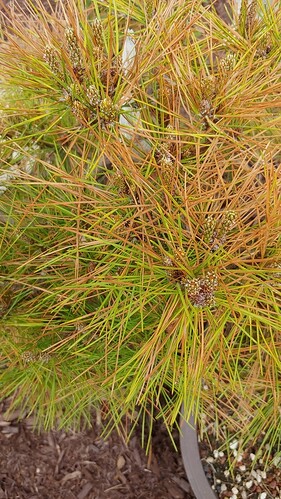I have a Scots Pine that appears to have Needle Cast. I noticed it on a lower branch a couple of weeks ago, and now it is spreading across the tree. The candles are plentiful, look healthy and are extending very well. I was going to start pinching them back, but now that the Needle Cast is spreading, should I pinch at all.
If the tree loses a lot of last years needles it will lose strength. If I let the candles extend and harden off then the tree will have fresh solar panels to strengthen it again. If I don’t pinch, then I lose the development effort I have invested in the tree for the past 2 years.
I have sprayed the tree (and my other pines as well) with Daconil, and will do so again every month until winter.
Thoughts? Advice?
Thanks 
1 Like
I would not pinch the candles except for those that are exceptionally strong. It needs the foliage to store up for this coming winter. If it looses all of its old needles that will be a similar needle reduction as pinching in a normal year and it is apt to back bud anyway. Even if it is does not back bud much it is better to lose a year of development by leaving them than all of the bad things that could result from not having enough foliage. I have a Scots that was coming along nicely a few years back and decandled it before I knew better. When combined with a soil that contained a moderate amount of bark I nearly lost it. It took about 5 years to fully recover.
1 Like
Thanks Marty. That’s what I was looking for. I was using a reduced fertilizer regime this spring to start on reducing the needles. Do you think I should increase the fertilizer dosage to try and add strength? I know with sick trees you should not fertilize, or fertilize at low levels. Thanks again.
1 Like
I would fertilize moderately and consistently. Your issue is the foliage is under attack by needle cast so the tree needs to be strong to fight back. We are hoping the roots are in good shape so they should be able to take up the fertilizer. My understanding of why not to fertilize is if we have root issues including fresh repotting to allow the roots to simply grow.
How long are your needles? The needles on the one I nearly lost which is now moderately well ramified are 25 mm long. It gets the same fertilizer as the ones further back in development that have 50-60 mm long needles. They all get candle pinched as I walk through the benches - long candles get pinched until they start to open up. The difference is the number of growing points is much denser.
1 Like
Last year’s needles are about 2-3 inches in length. The tree is about 7-8 yrs old, with a base that is about 2.5-3 inches in diameter. It was repotted in 2017 by the bonsai store I bought it from. The tree is in a good media mix that drains well. It has had a strong fertilizing regimen since I bought it, until this spring. It has back budded well the past 2 years, which is why I wanted to start reducing the needle length and then reducing branch length later this year.
Thanks again for the feedback.
1 Like
What sort of bud and branch density do you have. At that age and size the tree is still a young one and will have have long needles until it has lots of branching. One thing I have learned on Mirai is that the way to get back budding on pines is to get them growing really, really strong which often leads to longer needles. Get the budding and branching where you need it and then work on reducing the needle size beyond what happens naturally as the density increases.
I took pictures showing the density and needles on two of my Scots pines. The denser one is the apex region of the one that I feel has moderate ramification and 25 mm needles (it needs a complete wiring, but I am working up that level of time commitment to one tree this year). The more open one that is wired has 50 mm needles and I need to develop more back budding. If you look closely you can see some of the back buds that are developing.
1 Like
A quick further note is that I don’t pinch back the candles on Scots pine when I am trying to force back budding unless they are exceptionally strong and would rob the other branches of needed resources. I also fertilize heavily.
The first picture shows the first branch (lower primary) that showed the signs. The other two are different areas of the tree. I think at this point, I am going to just constantly check the tree, remove any dead needles, not pinch the candles and give it a decent fertilizer load to keep up the strength of the tree and see how it goes.
Thanks again for your advice.
Bob





